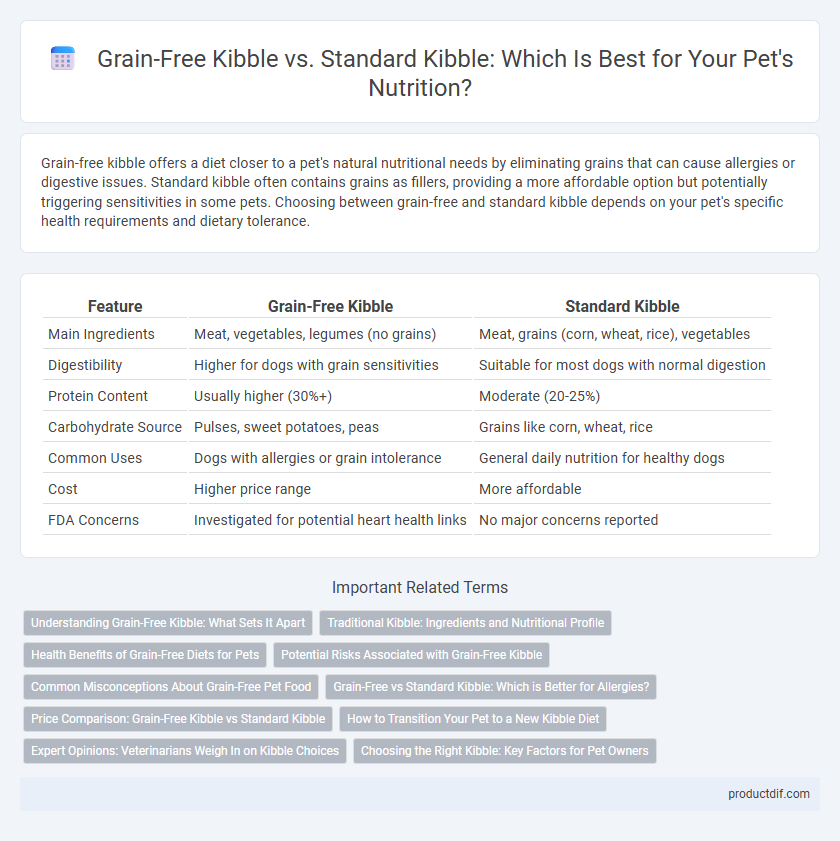Grain-free kibble offers a diet closer to a pet's natural nutritional needs by eliminating grains that can cause allergies or digestive issues. Standard kibble often contains grains as fillers, providing a more affordable option but potentially triggering sensitivities in some pets. Choosing between grain-free and standard kibble depends on your pet's specific health requirements and dietary tolerance.
Table of Comparison
| Feature | Grain-Free Kibble | Standard Kibble |
|---|---|---|
| Main Ingredients | Meat, vegetables, legumes (no grains) | Meat, grains (corn, wheat, rice), vegetables |
| Digestibility | Higher for dogs with grain sensitivities | Suitable for most dogs with normal digestion |
| Protein Content | Usually higher (30%+) | Moderate (20-25%) |
| Carbohydrate Source | Pulses, sweet potatoes, peas | Grains like corn, wheat, rice |
| Common Uses | Dogs with allergies or grain intolerance | General daily nutrition for healthy dogs |
| Cost | Higher price range | More affordable |
| FDA Concerns | Investigated for potential heart health links | No major concerns reported |
Understanding Grain-Free Kibble: What Sets It Apart
Grain-free kibble distinguishes itself by eliminating common grains such as corn, wheat, and soy, replacing them with alternative carbohydrate sources like peas, lentils, and sweet potatoes to better suit pets with grain sensitivities or allergies. This type of pet food often features higher protein content and reduced filler ingredients, aiming to support digestion and maintain healthy weight. Understanding these differences helps pet owners make informed choices tailored to their pet's nutritional needs and potential food intolerances.
Traditional Kibble: Ingredients and Nutritional Profile
Traditional kibble typically contains grains such as corn, wheat, and soy, which serve as primary carbohydrate sources and provide essential vitamins and minerals. These ingredients contribute to a balanced nutritional profile but may cause digestive issues or allergies in some pets sensitive to grains. Standard kibble usually offers a cost-effective option with a mix of protein, fats, carbohydrates, and added nutrients to support overall pet health.
Health Benefits of Grain-Free Diets for Pets
Grain-free kibble eliminates common allergens like wheat, corn, and soy, reducing the risk of food sensitivities and digestive issues in pets. This diet often includes higher protein levels from meat or fish, promoting lean muscle development and sustained energy. Many pet owners report improved coat quality, reduced inflammation, and better overall vitality with grain-free diets compared to standard kibble.
Potential Risks Associated with Grain-Free Kibble
Grain-free kibble may pose potential risks such as nutrient imbalances and increased chances of heart conditions like dilated cardiomyopathy (DCM) in dogs due to low taurine levels. Some grain-free formulas replace grains with high amounts of legumes and potatoes, which can affect digestibility and lead to gastrointestinal issues. Pet owners should consult veterinarians to choose diets that address specific health needs without compromising essential nutrient intake.
Common Misconceptions About Grain-Free Pet Food
Grain-free kibble is often misunderstood as inherently healthier, yet many pets do not require grain elimination for optimal nutrition. Studies show that grain-free formulas sometimes compensate with higher fat and carbohydrate content, which can impact pet health negatively if not balanced properly. Nutritional adequacy depends more on ingredient quality and overall diet formulation than the mere absence of grains, dispelling myths that grain presence alone causes allergies or digestive issues.
Grain-Free vs Standard Kibble: Which is Better for Allergies?
Grain-free kibble is often recommended for pets with allergies because it eliminates common allergens like wheat, corn, and soy found in standard kibble. Many dogs with food sensitivities benefit from novel protein sources and carbohydrate alternatives such as sweet potatoes or peas in grain-free formulas. However, allergy management depends on identifying specific allergens, so consulting a veterinarian for tailored advice is essential.
Price Comparison: Grain-Free Kibble vs Standard Kibble
Grain-free kibble typically costs 20-40% more than standard kibble due to higher-quality ingredients and specialized formulations. Standard kibble remains the more budget-friendly option, often priced between $0.50 to $1.00 per pound, while grain-free varieties can range from $1.00 to $1.50 per pound. Pet owners prioritize budget or dietary needs when choosing between grain-free and standard kibble in the pet supply market.
How to Transition Your Pet to a New Kibble Diet
Transitioning your pet to a grain-free kibble diet requires a gradual process over 7 to 10 days to avoid digestive upset. Begin by mixing 25% grain-free kibble with 75% standard kibble, gradually increasing the grain-free portion while decreasing the standard. Monitor your pet for any signs of allergy or intolerance, and consult your veterinarian to ensure a balanced change tailored to your pet's specific nutritional needs.
Expert Opinions: Veterinarians Weigh In on Kibble Choices
Veterinarians emphasize that grain-free kibble may benefit pets with specific food allergies or sensitivities, reducing digestive issues and improving coat health. Standard kibble remains favored for most pets due to balanced nutrition, affordability, and proven safety backed by extensive clinical data. Experts recommend consulting with a veterinarian to tailor kibble choices based on individual pet health profiles and dietary needs.
Choosing the Right Kibble: Key Factors for Pet Owners
Choosing the right kibble involves assessing your pet's specific dietary needs, such as sensitivities to grains or food allergies commonly found in grain-free formulas. Nutritional content, ingredient quality, and your pet's health conditions like obesity or digestive issues are crucial in determining whether grain-free or standard kibble is optimal. Veterinarian recommendations and understanding the source of protein can significantly influence the decision to support overall pet wellness and longevity.
Grain-Free Kibble vs Standard Kibble Infographic

 productdif.com
productdif.com